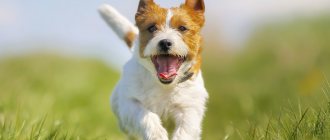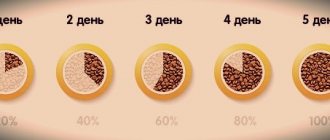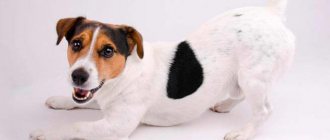Jack Russell Terrier - features of the breed
The Jack Russell Terrier and the Parson Russell Terrier are related breeds descended from the world-famous ancestor, the Fox Third. The breed was bred in England and has been actively used in work throughout its history.
Lately, the Jack Russell, better known as the “Musky dog,” is increasingly being seen as a family pet. However, the characteristics of the breed, “tailored for work,” have not gone away, which is the reason for the disappointment of many inexperienced owners.
The Jack Russell is a relatively problem-free, but very active dog.
From the first day in the new home, the puppy is guaranteed to make a splash. Even one-month-old babies are constantly on the move. They fall and fall asleep where they are playing, but soon they jump up and continue to do what interests them. These four-legged animals are literally tireless, they need a very high-quality diet, but do not require scrupulous care.
How to choose the right Jack Russell Terrier puppy
A potential buyer of a Jack Russell puppy, having started his search, should know that even if the dog is purchased “for the soul” and there are no plans for the pet to have a show career, it is not worth purchasing a baby without documents .
Each Jack Russell must have a document confirming its purebred. A purebred dog not only has a certain set of physical characteristics and a special temperament corresponding to the breed.
These qualities have been cultivated for several decades, and it is only thanks to their combination that the Jack Russell Terrier breed is so attractive and good.
A dog without documents may not grow up to look like a Jack, have a temperament that is not typical for the breed, or have a set of various genetic diseases. Why does the future owner need such a lottery if he wants to buy a cheerful, fearless and charming terrier? Large nurseries or a breeder who has one breeding bitch, when selling babies, must provide the buyer with all the documents he is interested in regarding the parents of the puppy . In addition, when selling a purebred dog, he has a puppy certificate, plus a veterinary passport.
The age of the baby also matters. You cannot buy a one-month-old puppy. According to the rules, puppies are certified by a livestock specialist and a club representative no earlier than forty-five days from the date of birth . After this, the baby is ready to go to a new family, but experienced breeders prefer to raise babies until they are two months or even three months old. Such a dog has already completed a course of vaccinations, shows his inherent character, and a knowledgeable person can easily determine how promising the baby is for exhibitions.
Experienced breeders know that in any litter, among the little Jacks, there are future stars and the most ordinary-looking puppies. Babies that are promising for exhibitions are sold at a higher price . When purchasing, you can ask the breeder what kind of puppy he can recommend, telling you about your expectations and preferences.
Important! Usually, families with small children, as well as beginners, are advised to buy female dogs, as they are calmer and gentler in character. Stubborn, leadership-prone males feel great with an owner who knows how to handle dogs.
How to choose the right puppy? You should not buy the largest baby in the litter.
When Jack Russell Terrier puppies grow up, they will all be approximately the same size; it is more important that the baby has the correct body proportions, bite, and temperament characteristic of the breed. There is no need to choose the smallest dog out of pity.
Too much lag in growth compared to littermates may indicate any problems in health or development.
A small Jack Russell should be cheerful and friendly, actively interested in guests and noisy with littermates. It is impossible to frighten him with a loud sound or confuse him with a new toy. Sitting quietly in a corner, not interested in new people, is either sick or a coward, which a Jack should not be .
In addition to the correct body proportions corresponding to the breed's temperament, the puppy must be absolutely healthy. A shiny coat, clear eyes and skin are signs of health. The baby should be normally developed for his age, have strong limbs, and be fairly well-fed.
Choosing a place and utensils for feeding the puppy
The puppy eats quickly and a lot, despite its modest size. It should be taken into account that eating for a Jack Russell is a passing activity; the puppy quickly runs up to the bowl, swallows what is in it and switches to a more interesting activity.
What should you pay attention to when choosing a place and utensils for feeding?
- In order to prevent diseases, the puppy's eating area should be clean.
- In order to prevent injury, care must be taken to ensure that the student does not slip when running to the bowl, even if the floor is wet.
Important! When choosing bowls, it is better to give preference to models with low sides. The bowl should be made of ceramic or stainless steel. It is better not to use plastic accessories.
What to feed a Jack Russell puppy - choosing the type of diet
One of the keys to raising a healthy dog is a quality diet. What to feed a Jack Russell puppy? First of all, you need to decide on the type of diet:
- Natural feeding.
- Feeding with prepared food.
- Mixed feeding.
Each type of diet has pros and cons. When making a choice, you need to rely on the needs of the pet and the possibility of fully compensating for them.
Natural diet
Despite constant advances in the production of prepared animal feeds, natural feeding remains a higher priority option.
A natural diet for a Jack Russell puppy includes:
- Feeding raw and cooked foods.
- Feeding meat porridge.
- Feeding exclusively raw foods is a raw food diet.
Benefits of a natural diet:
- Freedom to choose the quality of products.
- Product freshness control.
- Ability to regulate caloric intake.
- Comparative financial accessibility.
Flaws:
- Time-consuming – you need to prepare food for the dog separately.
- Allergies are possible, especially when feeding chicken.
- Food spoils quickly and should not be left in a bowl.
- It is necessary to constantly monitor the amount of vitamins and minerals in the diet.
Natural products are introduced into the diet of a Jack Russell puppy from the age of one month or earlier. If the puppy is orphaned, it can be fed with natural milk or specially prepared formulas.
Ready-made feed
Ready-made food is gaining more and more popularity and its main advantage is convenience for the owner. Ready-made feeds are divided into types:
- Dry (granules).
- Semi-moist (pieces with gravy).
- Moist (pate or paste).
- Treats.
The type of food is important for the prevention of dental and oral diseases; otherwise, the quality of the product plays a key role. Industrial feeds are divided into classes:
- Economy
- Premium
- Super premium.
- Holistic.
If a dog has allergies or other characteristics, food should be chosen from a specialized line. According to their intended purpose, ready-made feeds are divided into:
- Everyday.
- Supportive.
- Preventive.
- Medicinal.
- For exhausted animals.
- Hygienic (usually treats).
Advantages of ready-made feed:
- No need to cook.
- They are stored for a long time.
- Each pack contains recommendations for calculating the daily requirement.
- High-quality products are balanced, enriched with vitamins and microelements.
Disadvantages of ready-made feeds:
- The dog should not be fed only dry or wet food.
- High-quality feed is more expensive than a natural diet.
- Expensive food is often counterfeited.
Ready-made food can be introduced into the diet from the first day of life. A substitute for bitch's milk is used as supplementary feeding or artificial nutrition. Wet food is introduced into the diet no earlier than one month of age.
Mixed diet
A mixed diet involves the introduction of both natural products and ready-made food into the diet.
Benefits of a mixed diet for a Jack Russell puppy:
- Convenience for the owner - you can feed the dog food if you don’t have time to prepare the porridge.
- With mixed feeding, the puppy gets full faster and stays full longer.
Disadvantages of a mixed diet for a Jack Russell puppy:
- Dysbacteriosis, indigestion, diarrhea, constipation, especially in puppyhood.
- Rapid weight gain.
- Threat of hyper- and vitamin deficiency.
Veterinarians and pet food manufacturers are against mixed feeding, but the experience of many owners suggests otherwise. A puppy can be switched to mixed feeding no earlier than 4–5 months of age.
Natural nutrition
If the breeder fed your pet natural products, then do not forget to specify which ones, and follow this menu. If the baby was fed ready-made food, gradually switch it to natural food.
To begin with, it is enough to give a new species 1 teaspoon at a time, then alternate between dry food and natural food. But you should not delay the transition period for more than a week.
Meat broths are the first to be introduced into the diet, which can be used to dilute dry food. Next, vegetables and porridges are introduced: rice, buckwheat, oatmeal. A small two-month-old pet is given milk porridge once a day.
From two months onwards, you can feed your Jack Russell puppy finely chopped boiled meat, which should be lean. It is advisable to pre-boil vegetables during this period.
But for three-month-olds, you can add raw vegetables to the porridge. At this age, the dog is given cottage cheese, vegetable oil, and fruits.
The daily diet of a young Jack Russell Terrier should approximately contain:
- meat—200 gr;
- cereal products—150 gr;
- vegetables – 100 gr;
- dairy products - 100 mg.
In addition, bone meal is added to the food, at least 15 grams and one egg once a week. Food is served warm; food should not be served directly from the refrigerator. It is best to prepare them immediately before use.
If, when consuming factory-made products, the volume of food corresponds to the instructions, then with natural feeding, the portion is calculated based on the dog’s weight.
Since the Jack Russell Terrier is a hunting breed, the daily food intake (should not exceed 6% of weight) is divided by the number of feedings.
- Hunting dogs gain weight quickly, but musculoskeletal mass does not develop so rapidly. Therefore, overeating can eventually affect movement, positioning of limbs, and lead to metabolic disorders.
However, underfeeding will lead to slower growth and the development of rickets.
To determine the norm, watch your baby. He must eat the entire portion and lick the bowl. But when a pet tries to push the bowl after eating and doesn’t want to leave, it means that there isn’t enough of it. Therefore, at your next meal, increase the serving size by a quarter. If there is food left, then reduce the remainder or reduce the number of meals.
Sample menu by age for a Jack Russell puppy
To understand how and what to feed a Jack Russell puppy, you need to create a sample menu by age. You need to put your pet's needs first, taking into account its activity.
Menu for a puppy up to a month old
Until the age of one month, puppies must receive their mother's milk. If the baby is orphaned for some reason, he needs to be artificially fed:
- A natural menu for a Jack Russell puppy under one month of age is natural goat milk diluted with boiled water. Special mixtures based on milk and glucose.
- Industrial menu for a Jack Russell puppy under one month of age - bitch milk substitute or infant formula.
The serving size depends on the size and individual characteristics.
Number of feedings:
- From birth to 2 weeks, Jack Russell puppies eat every 2 hours.
- From 2 to 4 weeks, Jack Russell puppies eat every 2-3 hours, with a night break lasting 4-6 hours.
Note! The fewer puppies in the litter, the less often they eat as they receive more milk at a time.
At the age of 1 month
At 1 month, Jack Russell puppies begin to leave the nest and receive complementary food.
Natural menu:
- Mother's milk.
- Whole goat or cow's milk.
- Low-fat broth.
- Boiled minced meat mixed with broth.
If the puppy was fed or supplemented with a bitch's milk replacer, it is not recommended to switch it to a natural diet immediately.
Industrial menu:
- Bitch milk substitute.
- In case of growth retardation - pate for emaciated puppies.
Serving size depends on growth rate. The number of feedings (complementary feeding) of a puppy at the age of 1 month is 5–6 times a day, excluding mother’s milk.
At 2 months
At 2 months, Jack Russell puppies have a full set of baby teeth, but continue to eat their mother's milk. The complementary feeding menu is gradually expanding.
Natural menu:
- Mother's milk.
- Whole cow's or goat's milk.
- Calcined cottage cheese.
- Dairy products.
- Bouillon.
- Boiled minced meat.
- Ground, raw, boiled meat.
Advice! It is not recommended to switch artificially fed puppies to a natural diet at the age of 2 months.
Industrial menu:
- Bitch milk substitute.
- Canned food for small breed puppies.
Serving size directly depends on body weight.
The number of feedings varies from 4 to 6 times a day, excluding mother's milk consumed.
At 3 months
At 3 months old, Jack Russell puppies are preparing to go to a new home. For the first 10–14 days after moving, the diet and feeding schedule do not change. After adaptation, you can switch the puppy to the type of diet you choose.
Natural menu:
- Mother's milk (if the puppy is still with its mother).
- Whole milk, fermented milk products, cottage cheese.
- Boiled minced meat, raw, chopped meat.
- Broth, vegetable soup with meat broth.
- Raw quail eggs. Chicken eggs: yolk only, boiled or in the form of an omelet.
- Rice, buckwheat.
If you plan to feed your dog dry food, it is better to stick to a diet of ready-made food.
Industrial menu:
- Bitch milk substitute.
- Canned food for small breed puppies.
- Semi-moist food for small breeds.
Portion sizes are constantly growing. The difference in size is not particularly noticeable, but the baby is actively gaining muscle mass.
Number of feedings: 4–5 times a day.
At 4–6 months
At 4–6 months of age, the puppy should receive deworming and basic vaccinations. In addition, during this period, the pet’s teeth will begin to change.
In addition to expanding the diet, the Jack Russell puppy should receive vitamin supplements.
Natural menu:
- Whole milk, fermented milk products, cottage cheese - in large quantities.
- Boiled and raw meat without fat and bones - beef, veal, rabbit, turkey, quail.
- Beef by-products, boiled, chopped. You can use peeled, washed tripe in its raw form.
- Chicken and quail eggs – raw, boiled, omelet.
- Cereals – buckwheat, rice, barley, wheat and barley.
- Vegetables – boiled with porridge, raw with meat or cottage cheese.
High-quality feed contains a full range of vitamins and microelements, so feed additives are not required.
Industrial menu for a puppy aged 4–6 months:
- Pates for small breed puppies.
- Semi-moist food for small breed puppies.
- Soaked dry food for small breed dogs.
The serving size for a puppy aged 4–6 months depends on the individual characteristics and taste preferences of the dog.
Number of feedings for a Jack Russell puppy: 3–4 full meals and 2–3 snacks.
From 6 months to 1 year
At the age of 6–12 months, the puppy finally forms taste preferences. During this same period, allergies or individual intolerance may appear.
Natural menu for a Jack Russell puppy aged 6 months to 1 year:
- Meat – beef, poultry, rabbit.
- Meat by-products – beef, poultry.
- Milk (unless lactose intolerant).
- Fermented milk products - any, preferably homemade.
- Fish – low-fat, oceanic, peeled, boiled.
- Fish and meat broths.
- Chicken and quail eggs.
- Cereals – buckwheat, rice, barley, wheat and barley.
- Vegetables except boiled potatoes and raw cabbage.
- Fruits, except juicy and very sweet.
- Greens, grass, bran.
Industrial menu:
- Until the complete change of teeth (7–8 months) – wet and semi-moist food for small breed puppies, soaked dry food.
- After a complete change of teeth - 75% dry and 25% wet or semi-moist food for small breed dogs.
The serving size gradually increases, then, from the age of 8–9 months, it decreases.
The number of feedings is gradually reduced to 2–3 times.
What to feed an adult Jack Russell Terrier
By this time, energy requirements, with the exception of some physiological or physical activities, become somewhat less. Therefore, nutritional standards are somewhat reduced. But nutrition should still be complete.
It is better to feed your dog 2 times a day - morning and evening. The dog must have raw meat or other natural meat products at least 5 times a week, but not sausages; fish 2 times a week; 1-2 times eggs, every day vegetables in a variety of forms, fertilizing, rice and buckwheat from cereals. Once a week, the dog can be given a fasting day. It is better to give the meat boiled (beef, chicken breasts) for the first 2 weeks, then raw.
In summer, it is better to scald it with boiling water to avoid infections and worm eggs. Give the meat finely chopped. Completely exclude pork and lamb from your diet! An egg can be given 1-2 times a week, finely chopped, or soft-boiled mixed with the main food. Give any vegetables, raw, finely chopped (and grated smaller for puppies) and always with vegetable oil (1 teaspoon).
If possible, it is good to give crushed tomatoes without peels or tomato juice without salt (1 teaspoon every other day), adding them to food. Finely chop all the greens and mix with the main food (dill, lettuce, parsley, celery, etc.). Fish can only be given from the sea, without small bones and only boiled (hake, cod, sea bass, Argentina, navaga, etc.). Never give pollock! The fish is finely chopped and can be mixed with a side dish (rice, buckwheat, vegetables).
Twice a week, give 1-2 cloves of garlic, which are finely chopped and mixed with food. Dairy products. From dairy products it is better to give kefir, fermented baked milk, bifidok, cottage cheese, a little cheese (slice). While the puppy is small, grate the cheese on a fine grater and give it with porridge or dairy food. You can give calcined cottage cheese and make it yourself. Boil 1 liter of milk or kefir, then pour in 2 tablespoons of calcium chloride and let simmer for 2-3 minutes until completely curdled.
Then cool and place in a sieve or strain through cheesecloth. The resulting whey can also be given by adding cottage cheese to porridge. This cottage cheese is absorbed by the body by 97%, and along with it calcium, which the puppy needs for growth and bone formation. Mineral nutrition is given to the puppy starting from two months, adding it to food daily (the amount depends on the type of nutrition and the age of the puppy, so you need to carefully read the instructions for use).
Some quick tips on Jack Russell Terrier food:
1. The first meal in the morning should be liquid. 2. If the dog refuses raw meat, boil it with boiling water or boil it for 1-2 minutes. 3. Alternate meat dishes with dairy dishes. 4. It is useful to make one feeding vegetable. 5. Be sure to give special biscuits or crackers made from rye flour. They strengthen gums, clean teeth and are also rich in vitamin B. 6. Starting from 3-4 months, for the period of teeth change. Eliminate all solids. 7. Improper nutrition leads to various diseases and shortens the dog’s life.
Provide your dog with eating and drinking dishes intended only for him, as the puppy must be taught that he can only eat from his own dishes and is prohibited from eating from someone else's. The dishes must be stable enough so that the dog cannot knock them over or drag them in his teeth. The dishes are placed on a special stand. The dog should always have water. Bowls for food and water should be nearby.
What toys do you need?
The dog's favorite toys are a variety of toys made of special latex, balls and bones of dried beef or pig ears. She has a natural need to chew on something, so she plays with pleasure.
What documents should be available when purchasing?
A metric is included with the Jack Russell Terrier puppy. The exchange of metrics for a pedigree is carried out at the central office of SCOR / RKF, after passing the exhibition, at the age of up to 1.5 years.
Rebellion
The command to come to me should not be associated with restriction of freedom. It is necessary to call the puppy several times, praise it, reward it with something tasty, and only after the second or fifth time fasten it to a leash or pick it up. In the process of learning to follow commands - place, sit, etc. It is always necessary to show that you are not angry with the dog. That is, you seem to say: “Even though I force you, I still love you.”
We choose accessories for the Jack Russell: collar, leash, dishes, toys.
A collar is the most necessary item for your dog. The collar should not put pressure on the dog's neck, but at the same time it should fit the neck tightly enough so that the dog cannot throw it off. Outside the house, she should always and everywhere wear a collar, preferably with a tag attached to it with a special small tube with your address and telephone number.
The leash should be strong enough and approximately 120 cm long. At one end of the leash there should be a carabiner or clip for attaching to the collar ring.
Provide your dog with eating and drinking dishes intended only for him, as the puppy must be taught that he can only eat from his own dishes and is prohibited from eating from someone else's. The dishes should be massive and stable enough so that the dog cannot knock them over or carry them in his teeth. The dishes are placed on a special stand. The dog should always have water. Bowls for food and water should be nearby.
The dog's favorite toys are a variety of toys made of special latex, balls and bones of dried beef or pig ears. She has a natural need to chew on something, so she enjoys playing with both a ball and a bone.
Exhibition for Jack Russell Terrier
At exhibitions and broods, experts determine the breed, type of constitution and exterior of dogs. Registration for the exhibition ends 1 month before the event. Registration is paid, for which you need to fill out a special form (score sheet), and is done at the central office.
Exterior
- This is the appearance of the animal, which determines the breed, state of health and possible physical qualities.
At the exhibition, dogs should please the viewer's eye and facilitate the work of experts, who have to very carefully consider all the features, proportionality of build, quality and condition of the coat, nature of movements, type of behavior and everything that is associated with the exterior.
Despite the fact that at exhibitions only the exterior is determined, puppies must also be prepared mentally, since the result of the examination largely depends on how they behave in the ring.
Preparing a dog for examination should have the goal of bringing it to such an appearance that it best meets the requirements of the standard. Not least important is the decorative factor.
In the ring, the dog must have a special ring. A leash is attached to the collar, by which the dog is led counterclockwise around the ring. Leash in left hand, dog at left leg. All equipment should be light, soft and beautiful. It is advisable to show it in the ring (noose), absolutely not in a harness. At the exhibition, everything should be beautiful - the dog and its equipment, and for the audience, who perceive the picture as a whole, the behavior of the handler or owner plays an important role.
Psychological preparation
Dogs at shows find themselves in unusual conditions. Crowds of large numbers of people and dogs, and sometimes very loud music, do not go unnoticed for them. If this does not make much of an impression on adult dogs living in big cities, then on young dogs, especially those from the countryside, a sudden change in the situation can have a very strong impact, even to the point of temporary depression.
When going outside, try to change your usual walking routes as often as possible, sometimes visiting crowded places. Of course, this must be done gradually, without making sudden changes to the animal’s normal way of life.
Accustoming to dental examination is necessary, since at dog shows the change of baby teeth and the correctness of the bite are necessarily checked. To do this, sit the puppy next to him and, supporting the lower jaw with your right hand and the upper jaw with your left, say the command “Show your teeth.” At the same time, with your thumbs, carefully, without pain, spread his lips and inspect the bite, and then open his mouth to inspect the teeth. Encourage compliance with affection.
Movement around the ring
The dog should move around the ring at a walk or a light trot.
The leash is slightly stretched, the neck is located at an angle of 45′ to the horizontal, the back falls elastically down in a smooth arc. The stride is so wide that the hind limb is ahead of the one-sided fore limb. The body is carried very low to the ground, so the main direction of the push is forward, not upward. The dog moves freely, without visible effort and at the same time very impressive. Of course, such movements can only be achieved from a dog with an impeccable anatomical build, but many anatomical flaws can be compensated to a large extent by proper training.
There are several ways to teach the art of movement. The main thing is that the dog must visually, on command, search for someone or something. For example, the command is given: “Where is mom (dad, Sasha, Anya)?” Or: “Cat!” The main thing is that the subject of the search really interests her. Execution of the command is encouraged by a treat and the presentation of mom (dad, Masha, Vanya) or cat. In Russia, it is customary for family members outside the ring to call a dog by its name. Abroad, for these purposes, various whistles, sirens, etc. are used, the sounds of which dogs are accustomed to and to which they react as if called. This is more convenient, since you can ask any person unfamiliar to the dog to whistle, and sometimes dragging four family members to the exhibition can be problematic. Sound signals heard in various places around the perimeter of the ring keep the puppy on his toes all the time. By the way, this is why often the dog is shown not by the owner, but by a stranger, a familiar person - the dog is looking for an owner and looks great in the ring.
Exhibition stand
The handler’s task is to position the dog in such a way that all its shortcomings are hidden. The angles of the front and rear legs and the even arched topline should be shown. To do this, the owner needs, in the presence of a specialist, to try to put the dog in a winning position, remember this position and then repeat it every day, using a specific command (for example, “stance”) and reinforcing it with a treat. The dog must remember with its muscles (muscle memory) the position it takes in the stance.
At first it stands for only a few seconds, then it is placed in the rack for 3-5 minutes. Make sure that the front paws stand straight and parallel to each other, and the hind paws are spaced at a small pace. It is very important that the dog stands straight, without hunching, with his head held high. Very often, a beautiful or ugly stance affects not only the place occupied by the dog at the exhibition, but also its assessment.
You should arrive at the show early in order to make yourself comfortable with your dog, find out where your ring is and when the examination will begin. You will have time to groom your dog and give him some rest before the competition.
You should bring a water bottle and a towel for your dog.
Try to show your dog in the junior class as often as possible, and not only at major shows. The dog must gain experience so that in the future it will be easier for you to perform at the most prestigious events.
Veterinary recommendations
It is advisable to clean your ears weekly, using special products against otitis media and mites. The eyes are wiped daily with special products purchased in advance from a veterinary pharmacy or pet store. Do not forget about fleas and other parasites that may appear in a puppy; for treatment, special aerosols, collars or drops are used that are applied to the withers.
How to give your dog medicine? What is the least unpleasant way to take medications?
Do not open the dog's mouth; pull back the corner of your lower lip and pour in the medicine from a spoon or bottle. Elevate her head slightly and she will swallow the medicine. Place the ball or tablet on the tongue as deeply as possible and close the dog’s jaws.
But for some dogs, taking medicine internally is the most terrible torture invented by man. They clench their mouth tightly and refuse to open it, and if you can get them to open their mouth a little, they try with all their might to squeeze the fingers that give the medicine. It is difficult to get a dog to swallow liquid, especially if it is given in a spoon. It is better to spray with a stream from a plastic syringe. The syringe is filled with liquid, which is then carefully released into the dog’s mouth in a soft stream, making sure that nothing gets into the respiratory tract. Licking your nose means the medicine has slipped through. Since the dog should always come on command, it should never be called for such humiliation as taking medicine.
But the most reliable and, oddly enough, often the least unpleasant way of administering medications is by injection. Sometimes this is the only way to give the medicine.
Elizabethan Collar for Jack Russell
This simple device can be cut out of thick paper, cardboard, or thin plywood. On the dog's neck it is glued or stitched. It prevents you from scratching the sore spot and tearing off the bandage; it is used for inflammation of the ears and eyes.
Vitamins and supplements in the diet
High-quality industrial food is balanced, so there is no need to include any additives in the menu of a healthy puppy. If you plan to feed your puppy natural foods, vitamins and supplements should be introduced into the diet from an early age.
Natural vitamin supplements for Jack Russell puppy:
- Meat and bone meal.
- Clean, dried, crushed egg shells.
- Bran.
- Fish, chicken, beef liver.
- Greens, vegetables, fruits.
- Sunflower oil, olive oil.
- Brewer's yeast.
The pet gets vitamins from food and natural sources, but sometimes this is not enough.
Pharmacy vitamin supplements:
- Fish fat.
- Feed tricalcium phosphate.
- Omega-3, Omega-6.
- B vitamins.
- Undevit and analogues.
When feeding natural food, veterinarians recommend giving the puppy special, industrial vitamin complexes. The complexes are balanced according to age and needs.
What to feed a puppy
Restless terriers, cute short-legged “motors”, became especially popular in our country after the film “The Mask”. Jack Russell Terriers were bred in England for burrow hunting. In our country, these are mainly companion dogs.
When getting a cute baby of this breed, the owner should understand that this is not an indoor decorative dog. Experienced dog breeders say that the owner of the breed even needs to be able to “exorcise the devil.” All Jack Russell Terrier puppies have irrepressible energy, a desire to dominate and are always in an active search for adventure.
Food should become a source of energy for him and provide the growing body with all the necessary substances.
The owner needs to decide on the type of food: natural or ready-made dry food. Every 60 days it is recommended to review the diet, introduce new foods into it, and change the portion size. By the age of six months, you can make a choice in favor of one type of food or another.
Feeding a puppy between the ages of 1 and 4 months . During this period, tissue formation, weight gain and bone skeleton formation occur. You will have to feed often, but in small portions. Serving size is 10% of the baby's weight.
You should start by feeding seven times a day. At 2 months you can reduce it up to six times, and at 3 months - up to five. However, you need to make sure that the puppy does not remain hungry.
During this period, the basis of the diet of proper feeding includes: meat products (beef, veal, lamb, some chicken), cereals (buckwheat, rice, oatmeal), vegetables and fruits, eggs. Porridge is cooked for the puppy, adding meat and vegetable oil (1 or 2 teaspoons). The food is given warm, in crushed form.
Milk should not be included in your puppy's diet; it can cause far more problems with the gastrointestinal tract than it is good for. Give cottage cheese, kefir, low-fat yogurt in small quantities.
By six months , growth slows down, you can slightly reduce the caloric intake of food. This can only be done with cereals; you cannot reduce the amount of meat. By the age of 1 year, the dog is transferred to two meals a day, choosing the type of feeding.
If the owner wants to make caring for his pet easier, he can choose ready-made dry food. Note that such a choice should be made only if the baby has already been fed this way by the breeder. Otherwise, a sudden change in diet can cause serious gastrointestinal upset.
When choosing food, follow the manufacturer's recommendations. The packaging should indicate that it is intended for babies (“puppy”, “junior”).
It would be right to choose premium food and higher: Purina, Acana , Royal Canin and others. Despite the fact that small pieces of ready-made food are produced for puppies, they can be soaked. This will make it easier for the puppy to eat. You should not use milk for these purposes.
The serving size is calculated based on the weight of the animal, taking into account the manufacturer's recommendations on the packaging.
Of course, ready-made food is much more convenient to use, but it can cause allergic reactions. The owner needs to carefully monitor the health of the pet.
Natural food will perfectly provide a growing body with all the necessary substances. The inconvenience for the owner is the need to figure out how to diversify the pet’s diet and buy additional vitamins and microelements.
We also performed a detailed analysis of the following feeds: Proplan, Monje, Dog Chow, Brit.
Water in a Jack Russell puppy's diet
Water plays an important role in a dog's diet. When it comes to puppies who are constantly on the move, not drinking enough water poses too many risks. With a natural type of food, the puppy gets water from food, so it is reluctant to drink from a bowl.
Important! When kept on ready-made feed, the situation changes dramatically. A Jack Russell puppy should always have access to a drinking bowl with fresh water.
Feeding the puppy
- home
- Feeding the puppy
In order for your little Jack to radiate health and cheerfulness, develop harmoniously and have no health problems, you must approach feeding the puppy with special care.
The growth of a puppy is the most important period of his life, when bone and muscle mass is being formed and the correct structure of all body systems is being laid.
A growing body requires much more energy per kilogram of weight than an adult dog. The needs for proteins, vitamins, and various minerals are also much higher. Lack of protein during growth can lead to anemia, changes in constitution, and developmental delays. A lack of calcium and phosphorus in the diet leads to impaired bone formation.
Complete food for little Jack should include proteins, fats, carbohydrates, vitamins, trace elements and minerals.
Be sure to ask the breeder what food the puppy was fed and continue to feed him the same food for at least 7-10 days. Next, you must decide for yourself what you will feed the puppy - natural food or ready-made food. Accustom your puppy to the new food gradually. If you have opted for ready-made food, then it must definitely be super premium or premium food for small breed puppies. There is a large selection of them in pet stores.
If you decide to feed your puppy natural products, then their composition should be varied.
Meat - beef, turkey, chicken breast. It is better to give meat raw, because... it is better digestible and has a higher energy value than boiled meat (the meat must first be frozen and defrosted immediately before feeding so that the puppy does not become infected with helminths). The meat should be cut into small pieces, but not minced. In addition to protein, meat is rich in vitamin B, chlorides and phosphates, which are very useful for a young body.
Fish - fish should be given only of marine origin, preferably pre-cooked. In addition to protein, fish contains vitamin A, iodine, and phosphorus. Fish should be alternated with meat and the puppy should not be fed both foods at the same time.
Milk is an excellent source of protein, as well as calcium and phosphorus. However, milk contains lactose, and a puppy's young body can only digest a certain amount of lactose. If there is an excess of it, the puppy may experience digestive upset. Therefore, you should not give too much milk. Instead of milk, it is better to give ten percent cream diluted with water; it does not cause upset. It is very useful to include cottage cheese, made independently from milk, in the puppy’s feeding by adding calcium chloride while boiling. Cereals - corn, rice, wheat, rolled oats, buckwheat, are a source of vitamins and various vitamins. Give Jack well-cooked porridge in water mixed with meat or fish, as well as grated vegetables.
Raw vegetables, fruits and herbs are also healthy foods that contain, in addition to vitamins, fiber, which helps digest food. Give vegetables raw, grated. Although sometimes you can give it whole - when the puppy chews whole vegetables - this removes plaque from the teeth. Let your pet chew on a radish, carrot, or apple.
These are the main foods that should be included in feeding puppies; you should not feed puppies sweets or spicy foods.
Proper nutrition is not only a diet, but also a diet. Puppies 2-6 months old are fed 4-5 times a day. From 6 months, switch the puppy to 3 feedings a day.
After a year, the dog is fed 2 times a day, morning and evening.
When it's feeding time, put the food in the bowl and call Jack. Place the bowl on the stand and give the puppy the “eat” command. If the puppy refuses to eat or does not finish his portion, remove the food and do not leave it in the bowl. Don't worry: the puppy won't go hungry, don't coax him or feed him by hand. He will eat well at the next feeding. Believe me, not a single puppy has ever starved himself to death.
Don't forget about water: clean drinking water should always be in Jack's bowl.
Prohibited Products
It is important to exclude prohibited foods from your Jack Russell puppy’s diet:
- Bones, pure fat, skin, especially poultry.
- Palm oil.
- Grapes, raisins.
- Soy.
- Mushrooms.
- Corn and semolina.
- Raw freshwater fish.
- Dry, salted fish.
- Products containing sugar or sugar substitutes.
- Products containing xylitol (chewing gum, some sweets).
- Products containing flour or yeast.
- Products containing caffeine, cocoa, any stimulants (sweets, tea, coffee, chocolate).
- Products containing marinades, salt, spices.
- Smoked products, including sausages, balyki, fish.
- Expired products.
- Leftovers from the table.
Controversial products are:
- Lean raw pork.
- Raw ocean fish.
- Whole milk.
- Honey.
- Chicken eggs.
- Raw and boiled chicken liver in large quantities.
Controversial products can and should be given to a Jack Russell puppy if an allergic or other acute reaction does not occur after taking them.











